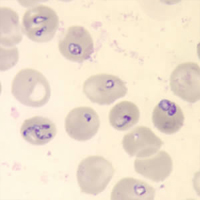Babesiosis laboratory findings: Difference between revisions
No edit summary |
|||
| Line 14: | Line 14: | ||
[[File:Babesiosisbloodsmear.jpeg|200px|thumb|center|Microscopic finding of Babesia parasites in red blood cells]] | [[File:Babesiosisbloodsmear.jpeg|200px|thumb|center|Microscopic finding of Babesia parasites in red blood cells]] | ||
==Gallery== | |||
<gallery> | |||
Image: Babesiosis05.jpg| This photomicrograph revealed the presence of an "older ring-form" of a Babesia sp. protozoan parasite in a blood smear. This older ring-form was located within an erythrocyte, and was displaying two chromatin masses. <SMALL><SMALL>''[http://phil.cdc.gov/phil/home.asp From Public Health Image Library (PHIL).] ''<ref name=PHIL> {{Cite web | title = Public Health Image Library (PHIL) | url = http://phil.cdc.gov/phil/home.asp}}</ref></SMALL></SMALL> | |||
</gallery> | |||
==References== | ==References== | ||
Revision as of 15:01, 11 June 2015
Editor-In-Chief: C. Michael Gibson, M.S., M.D. [1]
|
Babesiosis Microchapters |
|
Diagnosis |
|---|
|
Treatment |
|
Case Studies |
|
Babesiosis laboratory findings On the Web |
|
American Roentgen Ray Society Images of Babesiosis laboratory findings |
|
Risk calculators and risk factors for Babesiosis laboratory findings |
Overview
Babesiosis is easy to diagnose but only if it is suspected. It will not show up on any routine tests. It must be suspected when a persons with exposure in an endemic area develops persistent fevers and hemolytic anemia.
Laboratory Findings
Electrolyte and Biomarker Studies
Babesiosis can be diagnosed by direct examination of the blood, with serology, or with PCR-based tests. Other laboratory findings include decreased numbers of red blood cells and platelets on complete blood count.
Microscopy
In symptomatic people, babesiosis usually is diagnosed by examining blood specimens under a microscope and seeing Babesia parasites inside red blood cells. [1]

Gallery
-
This photomicrograph revealed the presence of an "older ring-form" of a Babesia sp. protozoan parasite in a blood smear. This older ring-form was located within an erythrocyte, and was displaying two chromatin masses. From Public Health Image Library (PHIL). [2]